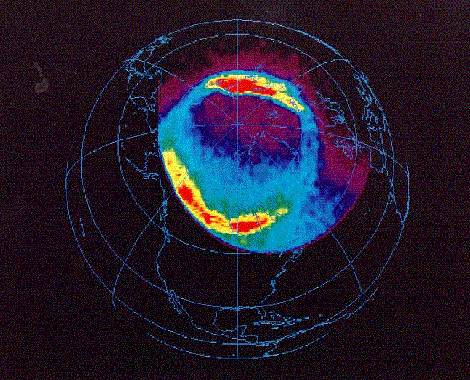Explanation: What do aurora look like from space? The POLAR spacecraft answered this by photographing an auroral oval surrounding the north pole of the Earth, causing displays on both the night and day side. The auroral sub-storm, pictured in false-color above, developed within 15 minutes and may have lasted as long as on hour. Aurora are caused by charged particles streaming away from the Sun and towards the Earth. As the particles fall to Earth, they spiral along magnetic field lines and cause colorful radiation. The UVI experiment onboard the POLAR spacecraft is equipped with special filters that allow it to see aurora in a band of ultraviolet light where sunlight is relatively dim. The more red the emission depicted in the above photo, the more intense the radiation. Earth's continents have been drawn in for clarity
1999 2000 2001 2002 2003 2004 2005 2006 2007 2008 2009 2010 2011 2012 2013 2014 2015 2016 2017 2018 2019 2020 2021 2022 2023 2024 2025 |
Yanvar' Fevral' Mart Aprel' Mai Iyun' Iyul' Avgust Sentyabr' Oktyabr' Noyabr' Dekabr' |
NASA Web Site Statements, Warnings, and Disclaimers
NASA Official: Jay Norris. Specific rights apply.
A service of: LHEA at NASA / GSFC
& Michigan Tech. U.
|
Publikacii s klyuchevymi slovami:
Earth - polyarnoe siyanie - Magnitnoe pole Zemli - Solnechnyi veter
Publikacii so slovami: Earth - polyarnoe siyanie - Magnitnoe pole Zemli - Solnechnyi veter | |
Sm. takzhe:
Vse publikacii na tu zhe temu >> | |
